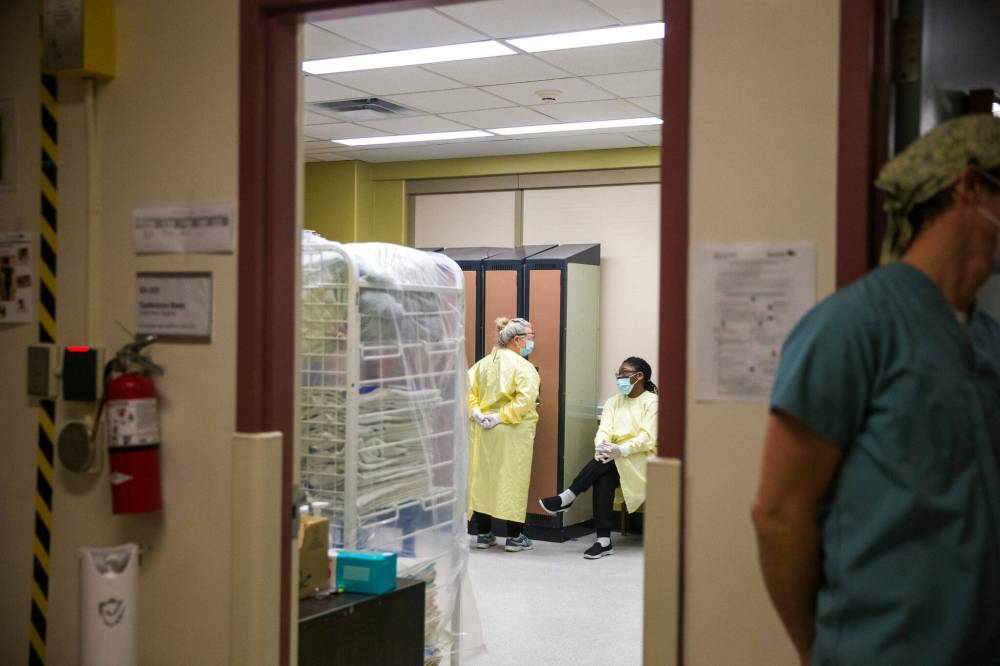COVID threat level ‘severe’ in Manitoba
Advertisement
Read this article for free:
or
Already have an account? Log in here »
To continue reading, please subscribe:
Monthly Digital Subscription
$0 for the first 4 weeks*
- Enjoy unlimited reading on winnipegfreepress.com
- Read the E-Edition, our digital replica newspaper
- Access News Break, our award-winning app
- Play interactive puzzles
*No charge for 4 weeks then price increases to the regular rate of $19.00 plus GST every four weeks. Offer available to new and qualified returning subscribers only. Cancel any time.
Monthly Digital Subscription
$4.75/week*
- Enjoy unlimited reading on winnipegfreepress.com
- Read the E-Edition, our digital replica newspaper
- Access News Break, our award-winning app
- Play interactive puzzles
*Billed as $19 plus GST every four weeks. Cancel any time.
To continue reading, please subscribe:
Add Free Press access to your Brandon Sun subscription for only an additional
$1 for the first 4 weeks*
*Your next subscription payment will increase by $1.00 and you will be charged $16.99 plus GST for four weeks. After four weeks, your payment will increase to $23.99 plus GST every four weeks.
Read unlimited articles for free today:
or
Already have an account? Log in here »
Hey there, time traveller!
This article was published 17/11/2022 (1118 days ago), so information in it may no longer be current.
The post-Thanksgiving surge in COVID-19 transmission is just starting to simmer down, but Canadians can expect it to flare back up as winter tightens its grip on the country, a national research group says.
“It’s still severe, but it’s slowly starting to go down. We’re seeing that across much of the country now, that those hazard index scores are declining somewhat. It’s still very high in Manitoba, and we have to wait until we get the next round of data,” said Tara Moriarty, a University of Toronto professor and co-founder of the COVID-19 Resources Canada research group.
Manitoba still has among the highest COVID-19 risk in the country.

The province is at a “severe” COVID-19 threat level for the third consecutive week, according to combined hospitalization and wastewater estimates and analysis that forms the Hazard Index which was current as of Nov. 11.
Recent spikes in transmission of the virus in Manitoba and the western provinces followed surges in Ontario and Quebec, Moriarty says, and early wastewater data from Quebec suggests another rise is beginning.
“There may be the start of a new surge happening there, and other provinces typically follow, but we need another week of data to know what’s happening for sure,” Moriarty said, explaining Quebec is generally quicker at reporting its data, and COVID activity isn’t necessarily higher there than in other provinces.
The Manitoba government didn’t publish the most recent weekly COVID-19 hospitalization figures, death toll and test positivity rates on Thursday, as has been the custom. Instead, a provincial government spokesperson stated the province plans to issue a combined COVID-19 and respiratory virus report each Friday, starting Nov. 18.
Influenza, Respiratory syncytial virus (RSV) and other illnesses are making some children seriously ill this season. The number of children’s emergency-room visits reached a record-high last weekend. While no longer at record levels, children are still going to the Children’s Hospital emergency department at a high rate. There were 150 visits to the children’s ER on Wednesday, Shared Health said.
Most of those young patients aren’t being admitted to hospital, a Shared Health spokesperson stated, saying the admission rate is still below normal. Of those 150 visits on Wednesday, eight children were admitted.
“Patient volumes at HSC Children’s emergency department remain elevated but are, for the moment, no longer at unprecedented highs. Ebbs and flows in patient numbers from day to day are expected, particularly at a time when viral and respiratory illnesses are circulating in the community,” Shared Health stated.
“So far in November, approximately 174.1 patients per day have visited the department. This remains slightly ahead of the record pace for any month set in December 2019, when the average number of patient visits to the ED was 170.3 per day. The daily average last month was 145.8 patients.”
Nearly 30 additional daily hospitalizations were predicted in Manitoba based on the current COVID-19 transmission levels (using late October data on estimated total infections), and the research group is able to see exactly how many hospitalizations happen because of the way Manitoba reports its data, but there is a lag, Moriarty said.
“I think what we’re seeing now across the country is that the post-Thanksgiving surge is finally slowing down,” she said.
Transmission is expected to rise throughout the winter as people stay indoors. Reinfection is still a problem, and less than 40 per cent of Canadians who haven’t had COVID-19 yet are susceptible.
“We’re likely to see quite a few more infections because there aren’t too many things that are slowing it or stopping it right now because we have quite poor (booster) vaccine uptake and very low masking in much of the country,” Moriarty said.
katie.may@winnipegfreepress.com

Katie May is a general-assignment reporter for the Free Press.
Our newsroom depends on a growing audience of readers to power our journalism. If you are not a paid reader, please consider becoming a subscriber.
Our newsroom depends on its audience of readers to power our journalism. Thank you for your support.




